Collections
Collections
1 The great importance of the forest industry to British Columbia's economy has caused almost every museum in the province to acquire some artifacts and frequently to create a small exhibit on some aspect of the industry. The pre-eminence of lumbering has also given rise to several museums which are devoted almost exclusively to this activity and to other museums which allot a significant part of their exhibit area to this subject. This brief review deals with the museums in southwestern British Columbia with significant lumbering artifact collections or with a major exhibition on the forest industry.
2 There are two major types of museums with forest industry themes. One is the indoor museum which devotes one or more galleries to portraying the subject. A detailed report of one of the two major exhibits of this type is provided below. (The other major indoor display was reviewed in an earlier issue of the Material History Bulletin and so is only briefly mentioned here.) The second type is the outdoor museum. Most of these are listed below together with a longer report on the British Columbia Forest Museum which holds the most important collection of lumbering artifacts in the province.
Indoor Museums
1) Vancouver Museum, Vancouver.
3 This museum's excellent forest industry gallery is highlighted by a detailed model of the Hastings Sawmill, the oldest in Vancouver. Adjacent to the sawmill model is the only period artifact the museum was able to locate, a mid-nineteenth-century circular saw. A double circular saw headrig has also been reconstructed. (This gallery was reviewed in Material History Bulletin 3 (Spring 1977): 56-61.)
2) British Columbia Forest Foundation, Vancouver.
4 The foundation was formed several years ago in order to increase the flow of forest-related information to the general public. In order to carry out this task the foundation has established a temporary exhibit in Vancouver and proposes to erect a major complex in the near future. The present operation concentrates mainly on educational presentations such as the hand manufacture of paper, but a small group of artifacts, such as a small block, an axe and similar equipment, are also exhibited and presumably this component will expand with the rest of complex.
3) British Columbia Provincial Museum, Victoria.
5 The Forest Industry Gallery is one of a series of large diorama galleries representing the major resource industries of British Columbia. Each gallery is independent of the other galleries but is designed to function as a part of a whole, portraying both the province's industrial dependence on the resource industries and the status of these industries in a roughly similar time frame but with a wide geographic dispersal. (A review of all Modern History Galleries was published in Material History Bulletin 12 (Spring 1981): 61-70.
6 The gallery's main diorama is a small sawmill consisting of headrig and carriage and located in the Rocky Mountain Trench in 1889. This is a crude sawmill with hewn timbers for the carriage and a small head saw, an example of the type of sawmill that might have cut ties for the Canadian Pacific Railway. In the background are additional saws, overhead line shafting, and some of the bits and pieces that would have been used to keep such a sawmill operating. This small but full-scale sawmill can be compared to a highly detailed scale model of a larger, more complex sawmill. The latter consists of a double circular saw headrig, a gang saw, an edger, and trim saws. The larger mills portrayed by the scale model were the centre of the growing lumber trade, but in 1889 they were still mainly concentrated on the coast while the smaller sawmills for local needs predominated in the interior.
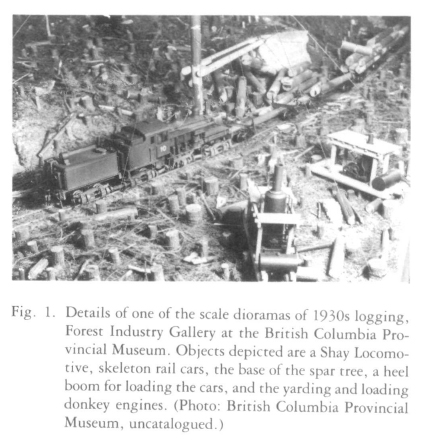 Display large image of Figure 1
Display large image of Figure 17 Logging, which must be considered as a completely separate aspect of the forest industry, is represented by several small artifacts, photographs, and two scale models. The small tools are standard items: axes, springboards, saw sets, long, two-man crosscut saws, timber stamp, oxen yokes, blocks, and hooks. There is also a scale model of a 1930s Hayes logging truck. Two small dioramas show a railroad logging operation ca. 1930. One is of a skyline and rail car loading operation, while the other shows the logs being dumped into the water from the rail cars and prepared for towing to the sawmill.
8 The gallery initially provides the visitor with the immediate impact of the forest industry at a particular time and in a particular location. The smaller artifacts and dioramas illustrate some of the other aspects of the industry. The exhibit does not provide a comprehensive understanding of the industry, not even for the time period of the main diorama, but instead creates an atmosphere and a feeling for the period.
9 The British Columbia Provincial Museum does not have an extensive collection of lumbering artifacts nor does it have the facilities to collect the larger items that are so important to the industry. Consequently, a representative collection of significant small items and accessories is being built. Instead of attempting to collect a bandsaw headrig, for instance, the museum has acquired the sawyer's control lever and a section of the saw. Such items will be used to represent the larger equipment that is difficult to collect and even more of a problem to exhibit.
Outdoor Museums
1) Heritage Village, Burnaby.
10 Several years ago this museum acquired the large collection of an old-time lumberman, Andy Anderson, of Powell River. The museum plans to set up the collection as an operating sawmill. In the meantime most of the collection is on display, though not arranged in order. The steam engines are in working condition and housed in a shed and are occasionally operated from the boiler of a donkey engine. The village's collection also includes "Old Curly," the oldest logging locomotive still in existence in British Columbia.
2) Shannon Falls Conservation Park, Vancouver.
11 Located a few miles north of Vancouver, the park comprises seventy-two acres on which a number of larger artifacts are displayed. These include a reconstructed water wheel, rod locomotive, locomotive crane, both steam and gas donkey engines, logging arch, lumber carrier, road grade, and a 1923 Federal logging truck. The displays have little interpretation or coherence and are rather a group of miscellaneous if interesting artifacts set in a beautiful location. Carling O'Keefe Breweries, which established the collection in conjunction with the International Woodworkers of America, has plans for continued development of the site.
3) Link and Pin Logging and Pioneer Museum, Sayward.
12 The museum was initially established to display logging artifacts because of owner-operator Glen Duncan's background as a logger. However, it is increasingly a local history museum which reflects the owner's interests, such as a fine collection of lamps on display in the museum building. Duncan's collection also includes a number of rare logging items — an "Empire" steam donkey engine, made in Vancouver, and an iron rake once used to remove bark and other clutter from an ox landing.
4) Arboretum and Logging Collection, Ladysmith.
13 Owned by Crown Zellerbach Canada, this collection includes a number of larger logging artifacts: two steam locomotives (a Shay and a Baldwin), a "Tyee" steam donkey, made in Vancouver, a railroad skeleton car, and a number of smaller items such as a Fordson gas donkey and a crawler tractor.
5) Saanich Historical Artifact Society, Central Saanich.
14 This museum is eventually to be operated as an old-time farm with corresponding display. The artifacts include, however, two steam logging donkey engines and a small operating sawmill.
6) British Columbia Forest Museum, Duncan.
15 The British Columbia Forest Museum, which has the most significant and complete collection of artifacts related to the forest industry in British Columbia, opened in 1965 under the direction of Gerald E. Wellburn. Wellburn had been collecting industry-related artifacts for over a decade prior to the establishment of the museum and his personal collection formed the core of the museum's collection. The museum is situated on a ninety-acre lake-shore site which also includes an operating narrow-gauge railway, an adjacent farm, a water fowl sanctuary, a demonstration Forest Service nursery of approximately 40,000 seedlings, and a stand of mature coastal forest.
16 The strongest part of the collection is that dealing with logging and probably the most spectacular items in the logging collection are the steam locomotives. The museum has seven, including three Shays, one of which occasionally operates on the railway, two Climaxes, and two operable rod engines. The Shays and Climaxes are closely connected to British Columbia's forest industry and while these two rod engines were never used in logging they are typical of some of the earlier types used. Other aspects of the railroad logging collection are not quite as complete. For instance, there are only two log hauling cars - a skeleton and a flat car without bunks. There are several small gas locomotives, however, and an operating gas crew speeder as well as hand cars, smaller speeders, and various tools. Even the steel rails of the railroad are artifacts, having been originally used by various logging operations.
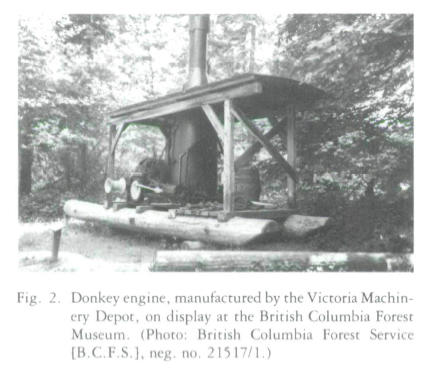 Display large image of Figure 2
Display large image of Figure 217 Artifacts related to changing logging technology are displayed throughout the museum grounds. Truck logging is represented by a 1918 Maxwell, a 1919 Republic, and a 1919 White. (Several later White trucks are not on display.) Several crawler tractors include a Holt, a Twenty cat with a logging arch, and a Cletrac 100 with bummer (a device to raise the ends of the logs from the ground while they are being towed). Two steam donkeys (cylinder size/engine stroke: 7 x 9 and 10 x 12), a duplex loading machine (10 x 12), a rigged Fordson donkey, and a Clyde diesel yarder portray the loading and yarding aspect of logging. The museum does not have a large skidder but a complete set of skidder rigging, including a five-ton carriage, are in storage. Innumerable smaller items are housed throughout the museum: fallers' tools, axes, cross-cut saws, chain saws (including a 1938 Stihl chain saw, the oldest remaining in the province), springboards, oil bottles, ox yokes, ox dogs and chains, climbing belt and spurs, various pieces of riggings such as slides hooks, butt rigging, blocks, tongs, and engineering equipment.
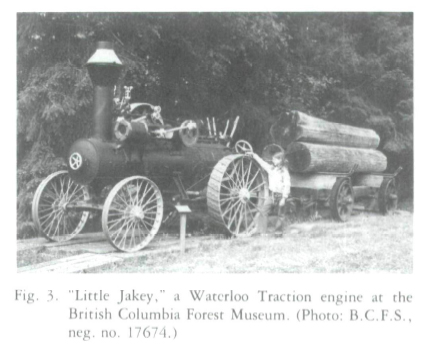 Display large image of Figure 3
Display large image of Figure 318 The development of logging is portrayed in a small log building with exhibits of some smaller artifacts, photographs, and an excellent series of dioramas. The dioramas, constructed by several different persons over the last fifteen years, begin with logging under Captain Cook at Nootka Sound in 1778 and the building of the "Northwest America" in 1789 by John Meares and then proceed to ox logging, rail logging, and truck logging. The series is to be completed by a diorama showing helicopter logging and a diorama of flume operation in the British Columbia interior. The visitor has a unique opportunity to understand logging, first by seeing the diorama and then by inspecting the full-size machine on the museum grounds.
19 The museum displays, however, are not limited to machinery. Something of the life of the logger is portrayed in a logging camp display. The camp consists of blacksmith shop, bunkhouse, combined office and first aid room, combined engineering office and repair shop, and cook-house. Each illustrates an aspect of camp life in showing that the logger is as important as the equipment.
20 Despite the excellent logging collection the museum's collection of materials relating to log processing is very weak. The only ones on display are a bull saw, straddle lumber carrier, small steam engine, yard locomotive crane, large fire pump, framework of a sawmill platform, and diorama of a small sawmill. Several traction engines are also displayed and while they were occasionally used to transport logs, they were much more frequently used to power small sawmills. A number of other items are in storage, including a bandsaw headrig, knee from a steam carriage, and several large steam engines. There are no artifacts to represent shingle milling and the only items relating to pulp and paper are two mechanical pulp grindstones of a type used at the massive pulp and paper plant at Power River.
21 In summary, the British Columbia Forest Museum possesses a very comprehensive collection of artifacts relating to logging (even including a complete tire vulcanizing plant for a truck logging operation). The British Columbia Forest Service has recently deposited its collection with the museum; this collection, together with a previously erected forest-fire lookout tower, provides an excellent selection of materials on fire protection and the details of government forest administration. The museum is weak, however, in artifacts relating to wood processing. One major area of concern is the lack of effective conservation undertaken on the collection. Many of the larger items remain exposed to the weather all year long and this has resulted in a rapid deterioration in their condition. The small amount of preventive maintenance undertaken in previous years was hardly sufficient to slow this deterioration. The addition of a full-time conservator to the museum staff was a step towards solving the problem and while he has recently left presumably he will be replaced.
22 The widespread interest of British Columbia museums in the forest industry has resulted in a number of worthwhile displays and has meant the creation of a fairly comprehensive collection of preserved logging artifacts in spite of some gaps. (A twenty-drum skidder has yet to be preserved, for instance.) It is in the area of the processing industries, however, that the greatest weakness lies and it is here that an intensive effort at preservation and display should be undertaken. The large sawmills are very inadequately presented, the massive pulp and paper industry has almost no place in present displays, and secondary components such as shingle mills have been completely ignored.
The Forestry Collection in the Glenbow Museum, Calgary
23 The collection as a whole is most characteristic of traditional hand logging operations; the few documented subjects deal with cordwood cutting and other activities by independent logging operators for personal or commercial use. With the notable exception of the vehicles, there is very little equipment representative of large-scale lumbering operations; similarly, very little in the way of camp furnishings or loggers' personal gear is to be found in the collection. This may be due in part to the forces of selective preservation and in part to passive collecting practised in the past. An active collecting programme would help to remedy the situation on both counts. A brief survey follows of the 125 artifacts in the existing collection.
24 Proportionally speaking, the focus is on traditional timber felling and bucking hand tools, such as falling and broad axes, wedges, falling and bucking saws, and augers. Sharpening tools are represented by grindstones and saw filing and setting tools. Scaling and marking tools include a set of tree calipers and board rules and several log stamping hammers. Skidding, loading, and other log transportation equipment range from cant hooks and peaveys, pulley blocks, skidding tongs and timber carriers to ox yokes and logging harness. Vehicles include logging wagons, a sawdust dump wagon, a bummer sleigh, and a pair of lumber wagons from Edmonton lumber yard.
25 In summary, the British Columbia Forest Museum possesses a very comprehensive collection of artifacts relating to logging (even including a complete tire vulcanizing plant for a truck logging operation). The British Columbia Forest Service has recently deposited its collection with the museum; this collection, together with a previously erected forest fire lookout tower, provides an excellent selection of materials on fire protection and the details of government forest administration. The museum is weak, however, in artifacts relating to wood processing. One major area of concern is the lack of effective conservation undertaken on the collection. Many of the larger items remain exposed to the weather all year long and this has resulted in a rapid deterioration in their condition. The small amount of preventive maintenance undertaken in previous years was hardly sufficient to slow this deterioration. A full-time conservator would be a step towards solving the problem.
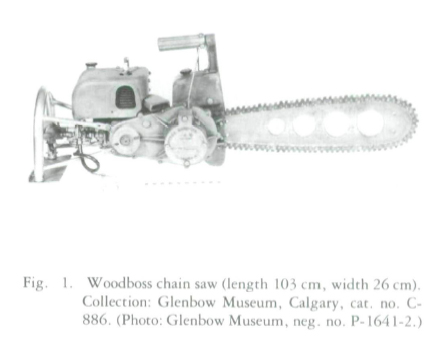 Display large image of Figure 4
Display large image of Figure 4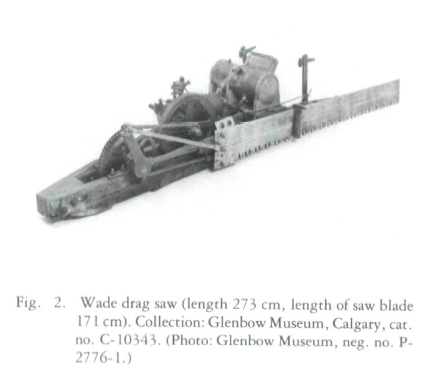 Display large image of Figure 5
Display large image of Figure 526 Power logging tools form a small but significant component of the collection. One of the three chain saws and an early gasoline-powered drag saw were reputedly used by cordwood cutting operators, the first supplying Banff residents, the second under contract to the Elk Valley brewery in the area of Elk River, British Columbia, near the Alberta boundary. The Woodboss chain saw in figure 1 was made by the Vancouver firm Power Machinery in 1945 or 1946; the other chain saws were made by Industrial Engineering also of Vancouver. The drag saw (fig. 2), manufactured by R.M. Wade and Company of Portland, Oregon, and Spokane, Washington, is chain-driven with a water-cooled single-cylinder two-stroke engine and a 171-centimetre-long saw blade.
27 Two handmade tools reflect a homesteading context. A Ukrainian shingle vise and bench, dated ca. 1909, came from Paradise Valley, Alberta. A horse-drawn plane from Seba Beach, Alberta, used for squaring logs, is equipped with a broad axe as a cutting blade.
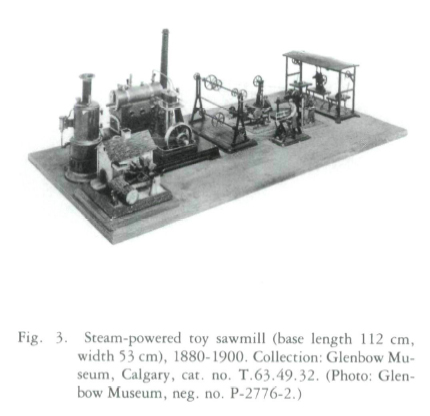 Display large image of Figure 6
Display large image of Figure 628 Of other items associated with forestry, two are singled out for mention: a forest trail marker and a sawmill toy. A roll of treated paper tape in a turned wood dispenser was reputedly used to flag forest trails. The steam-powered sawmill toy (fig. 3) was made by a prominent American manufacturer of steam toys, Weedon Company of New Bedford, Massachusetts, during the 1880-1900 period. It should be noted that in such late nineteenth-century "educational" toys, a selection of separate attachments was usually available for purchase; thus the particular configuration on this board may have expressed the owner's wishes, not necessarily a sawmill of the period.
29 The nature of the collection suggests a number of research questions and approaches, including Canadian tool manufacturing for the industry, the role of the power saw, historical perspectives on logging on the homestead and on the local lumbering industry. We hope to explore these and related questions in the future. In the meantime, visitors interested in examining the forestry collection are welcome.
Provincial Museum of Alberta
30 The Provincial Museum of Alberta in Edmonton has a small collection of hand tools related to the local processing of forest products for individual use. Included in the collection are pulling axes, saws, cant hooks, shipping tools, and other miscellaneous artifacts. With the exception of some saw blades from portable mills and a model of a log loader which was used at Canyon Creek in the north-central part of the province in the 1930s, the museum has no artifacts related to the commercial forest industry.
31 The Alberta Forest Service, a division of the Alberta Energy and Natural Resources Ministry, maintains a museum at the Forestry School in Hinton, Alberta, which houses artifacts related to the history of governmental timber management and protection.
Western Development Museum
32 The forestry industry artifacts in the Western Development Museum collection relate almost exclusively to the operation of one firm, The Pas Lumber Company, which operated in the Carrot River and Reserve areas of eastern Saskatchewan. The Pas Lumber Company was formed in 1918 when the Ladder Lake Lumber Company bought out the Finger Lumber Company at The Pas, Manitoba. It operated in Saskatchewan until 1958 when it moved to British Columbia.
33 Perhaps the most unusual artifacts which relate to the forest industry in Saskatchewan are two Phoenix Centiped log haulers. These machines were manufactured in Eau Claire, Wisconsin, after the turn of the century and were used to haul logging sleighs to and from the mills. The front of the engine was equipped with skis, the rear with tracks. An operator was required to ride in front to steer the skis. The log haulers are reported to have hauled up to thirty loaded logging sleighs over ice roads.
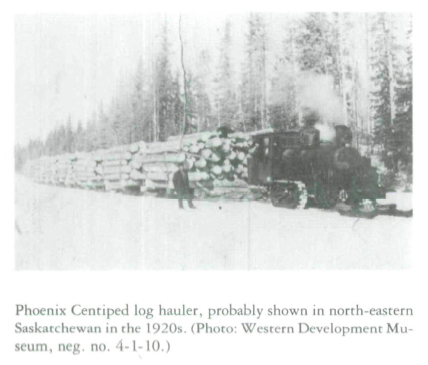 Display large image of Figure 7
Display large image of Figure 734 It is quite likely that one of the log haulers was purchased by the Sturgeon Lumber Company in the Prince Albert area in 1905. In 1912 Ladder Lake Lumber Company acquired it for use in the Big River area. Later, the Pas Lumber Company used the Phoenix Centiped in the Pasquia Forest Reserve from about 1921 to 1935.
35 Other artifacts in the collection include a logging sleigh, a lumber wagon, and shingle and planing mills as well as a number of early photographs of the logging industry. These artifacts, located at the Saskatoon, North Battleford, and Yorkton branches of the Western Development Museum, were collected primarily during the 1950s. Few artifacts relating to the forest industry have been added to the collection recently.
Pioneer Logging Exhibit — Algonquin Park
36 Algonquin's Pioneer Logging Exhibit, located on Highway 60 near the Park's East Gate, was established in 1959. The facility is designed to interpret the logging history of Algonquin Park — square timber, sawlog, and modern lumbering. Major exhibits on the site include a camboose camp, an alligator steam-warping tug, a stable, squared pine log, and a steam locomotive. A variety of implements are on display (for example, lumber wagon, barienger brake, pointer boat, and log sleighs), with accompanying interpretive messages to explain their functions in the lumbering industry.
37 A number of black-and-white historical photographs are used in the exhibit to help bring the bygone lumbering era to life. Visitors may also view an audio-visual programme, located in a small theatre on the site, which describes Algonquin's logging history and modern timber management. This show serves to place the exhibit's various displays in an historical context. All of the photographs used at the Pioneer Logging Exhibit were selected from a logging history archival collection of several hundred pictures maintained by the park, but not on public display. The park's archives also contains a number of oral history tapes dealing with logging in the area.
38 The Pioneer Logging Exhibit is manned by an historical interpreter who can explain the display in greater detail.
Forest Industry and Related Artifacts at the National Museum of Science and Technology
39 Because of restrictions on the recruitment of staff the National Museum of Science and Technology does not at the present time have a separate curatorial division for the forest industry. Responsibility for collecting in this field is therefore shared between the agricultural and industrial technology curators, with the former specializing in what might be termed the "secondary" aspects of the technology, for example small sawmills whose activities would have had a more direct impact on the farming community.
40 The holdings comprise several major collections that were purchased as entities together with a number of individual tools: most of the latter are fairly common and are usually well-represented elsewhere: for example marking hammers, cant hooks, etc. These tools were quite often included in collections purchased with other objectives in mind rather than being deliberately sought after; consequently there is some duplication.
41 Among the larger acquisitions of recent years are the following:
- The Henderson Axe CollectionComprises turn-of-the-century material discovered in a former hardware store in Dawson City, Yukon.
- The Walters CollectionThe contents of the Walters Axe Factory in Hull, Quebec, demolished in 1973. Includes a variety of products made during the 100 years or so during which this company figured prominently in the manufacture of products for the lumbering industry. Besides axes there is a selection of tools used in their manufacture: a trip hammer, a press, dies, etc.
- Items from the bush camps of the E.B. Eddy Co.Mainly equipment from the days of logging with horses: log binders, skids, skidplates.
- Corliss steam engineFormerly used to power the McRae mill at Rock Lake, Ontario; also headsaw and resaw blades from the same source.
- Sash and door factoryA virtually complete collection of machinery from Pembroke, Ontario.
- Equipment for making wooden pumpsThis dates from the first quarter of the century and has been mounted on a special trailer as a mobile exhibit. It is an important part of the extension programme of the Agricultural Division.
42 In addition to the above there are two saw collections, a portable sawmill and several saw carriages. With the exception of the pump-making equipment all the items mentioned are in storage but are available for examination by bona-fide researchers upon advance notice.
Artifacts relating to the forestry industry in the History Division of the National Museum of Man
Introduction
43 As some of the articles in this monograph indicate, the study of the forestry industry is important because it reveals significant aspects of Canada's history: colonialism, labour, technology, conservation and urbanization are examples of themes closely associated with the assault on the forest. Artifacts relating to this activity have always been an important part of museum collections. The National Museums have developed extensive holdings which correspond to their respective mandates and to different aspects of forest industries. Large machinery plays an important role in the collection of the National Museum of Science and Technology (see the report by John Corby) and hand tools form the largest part of the National Museum of Man's holdings. Increased collaboration between members of these two institutions is helping to eliminate competition and repetition and to complete the respective collections. The use of similar artifacts in exhibits leads, however, to a limited amount of overlapping.
44 Artifacts within the National Museum of Man are organized according to the institution's three main fields of interest: anthropology (archaeology and ethnology), folk culture and history. Only the latter two and especially the third, are the object of this report. The Canadian Centre for Folk Culture Studies possesses a number of objects including: relief carving done by a high-rigger on the west coast; logging camp scenes from New Brunswick; miniature skidding sleighs and other equipment; chip-carved spruce-gum boxes (often referred to as "bible boxes") and a few tools.1
45 The following description of artifacts held by the History Division is meant as an introduction to the collection. Limitations in time and space have led to the presentation of short, descriptive enumerations of the material. Though boring, this information is useful in analyzing further acquisitions and makes the task of comparing collections easier. Researchers interested in a more complete-inventory may consult the catalogues of the National Museum of Man.
46 Prior to the 1970s, members of the History Division collected an impressive number of artifacts, touching most aspects of the forestry industry. But with a few notable exceptions,2 the lack of personnel limited research on the subject in general and the artifacts in particular. The introduction of programmes sponsored by the federal government, such as summer-corps projects, alleviated this problem and stimulated a considerable amount of work in the field.
1. Research
47 Teams of summer-student researchers, supported by the personnel of the National Museum of Man and working in collaboration with provincial institutions, began researching the evolution of the forestry industry in British Columbia and Quebec. Researchers working on the subject in British Columbia and aided by the personnel of the British Columbia Provincial Museum and the Museum of Northern British Columbia, concentrated on two mills near Prince Rupert, Georgetown and Brown's Mill.3 While the history and artifacts of these mills were being documented, objects were acquired from individuals in the province and especially on Vancouver Island.
48 Although a preliminary investigation of available artifacts in the region north of the Gatineau River, and research on the timber trade and shipbuilding in Quebec City, have been completed, work in the province of Quebec have concentrated on the Trois-Rivières area.4 The bulk of this work was accomplished by students supervised by professors at the University of Quebec at Trois-Rivières. The latter (René Hardy and Normand Séguin) are preparing a monograph on the forestry industry for publication in the Museum's popular series on trades.5 This project has not included the analysis of available artifacts, but objects from the area are being acquired by Museum personnel.
2. Artifacts
49 Artifacts from the forestry industry in the Museum's collection include a number of areas, the largest of which are, first, those used in providing for the daily needs of men in the lumber camps and, second, hand tools. Kitchen utensils, personal belongings and objects used in leisure activities, are the principal groups of artifacts in the first category. The Museum possesses a large inventory of kitchen utensils, much of which is similar to the iron and tinware used in lumber camps (cooking pots and pans, kettles, tea and coffee pots and mugs, collanders and funnels). These utensils come from British Columbia, Ontario, Quebec, and the Maritimes and although most date from the post World War II era, many are hand-made artifacts (such as large tin baking sheets and tins cups from Quebec6), which date from the late nineteenth and early twentieth centuries. Personal objects used by lumber men are numerous, but still far from complete. Trunks, pack-boards, razors, pocket-knives, muskets, powder flasks, and animal traps are examples of existing material. Leisure activities are represented by playing cards, violins, tobacco tins and pipes and liquor bottles (especially whiskey and beer bottles). Clothing is limited mainly to footwear and includes items like early leather boots (bottes sauvages) worn in Quebec, caulk boots from British Columbia and different kinds of ice crampons worn on the boots of men working in the forests in the winter.
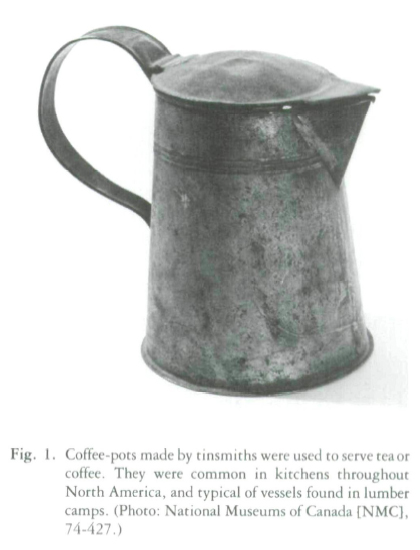 Display large image of Figure 8
Display large image of Figure 850 Accessories, hand tools and a limited number of early machines represent the largest part of the forestry collection. Accessories include a variety of hand-forged hooks, rings and bolts made for the industry by village blacksmiths7 and manufactured articles such as "cheeks", shackles, pins, pulleys, choker hooks, swamp hooks, bull-hooks, "L" hooks, etc.8 The Museum holds a wide range of small tools used in different aspects of logging: picks, hand drills, hammers, wrenches, and shovels are some examples of this type of artifact. Jacks, timber dogs, boom chains, augers, log-skidding tongs, picaroons, peavies and cant-hooks, illustrating various aspects of logging operations, are also well-represented.
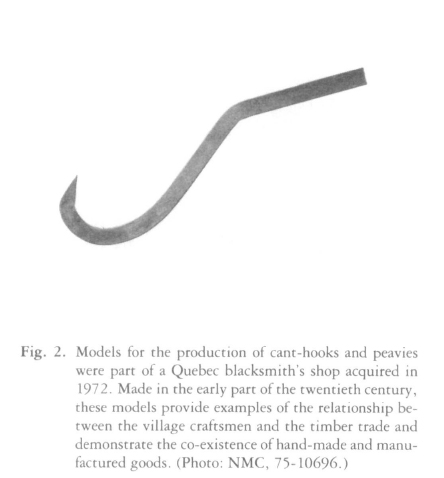 Display large image of Figure 9
Display large image of Figure 951 Hatchets, axes and saws from all areas of the country are well-represented. Axes, representing patterns from England, Europe and the United States, include broad, hewing and falling axes. A wide range of axes, from early eastern pit saws to the western falling and bucking saws, have been acquired. Large circular saws and early chain saws from British Columbia are among the rare examples of machinery in the Museum. Falling wedges, iron shoes, spring-boards, grinding stones, sawsets and gauges complete this part of the collection.
52 Related crafts supplying the lumbermen with goods or performing complementary tasks are represented by blacksmith, harness-making and wheelwright tools (including those used for grooming horses and repairing wagons) and by isolated groups of tools, such as froes, marking hammers, log scales and surveying equipment. The Museum possesses a good inventory of blacksmithing tools, some of which were used in the timber trade and is acquiring tools from shipbuilding, an industry closely related to the lumber industry in the Maritimes and Quebec. Contrary to craftsmen's tools, most of those used by lumbermen do not show the distinctive characteristics resulting from decades of care, selection and modification to personal requirements. Most of these tools show the effects of mass production and the demands made on them by large groups of men. The originality of hand-made tools has been replaced by utilitarian forms. Small hand tools have been replaced by large automated machines. An analysis of the tools in the Museum's collections would help portray developments responsible for altering the structure and orientation of the Canadian industry.
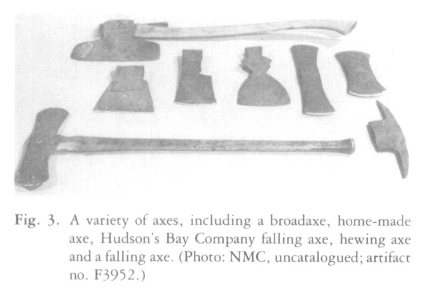 Display large image of Figure 10
Display large image of Figure 10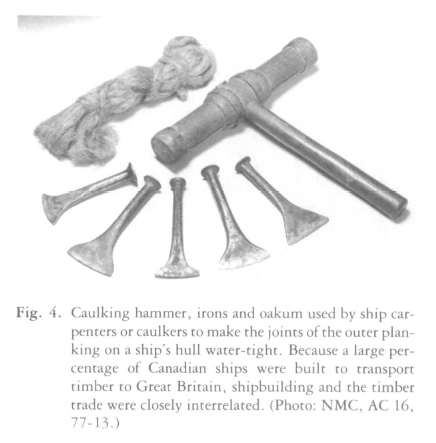 Display large image of Figure 11
Display large image of Figure 1153 The Museum's collection could be strengthened in a number of areas, the most important of which concern the daily needs and social life of the lumberman (domestic items such as clothing, wash basins, bedding, religious articles and objects relating to leisure and social activities), specialized functions of the trade (such as axe and saw-filling) and complementary industries and associations (transportation industries, forestry conservation and trade unions).
3. Diffusion
54 Artifacts and research have been used in the preparation of publications and exhibits. In addition to the monographs previously referred to in the text, a manuscript on shipbuilding in Quebec and a brochure on the permanent exhibit are planned for publication. Two exhibits, the permanent exhibit in the National Museum of Man in Ottawa and a travelling exhibit on woodworkers (to open in 1982), have drawn from work on the forestry industry. The research part of the museum's work was used in the exhibit storylines and the artifacts formed the basis of three-dimensional material illustrating the history of the forestry industry. By combining the acquisition of artifacts with research on the evolution of the industry, Museum personnel have been able to formulate a coherent policy of collection development in this field.